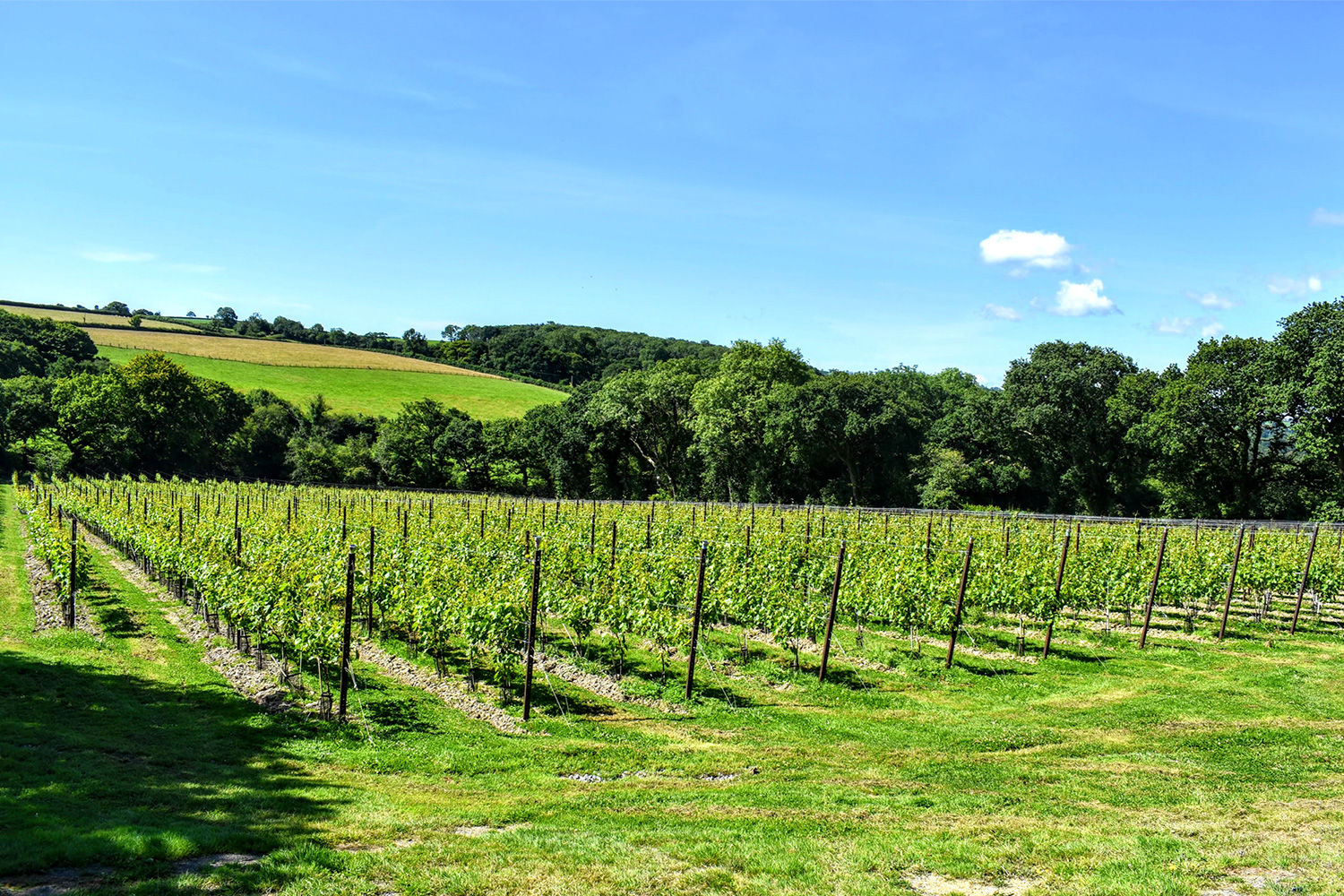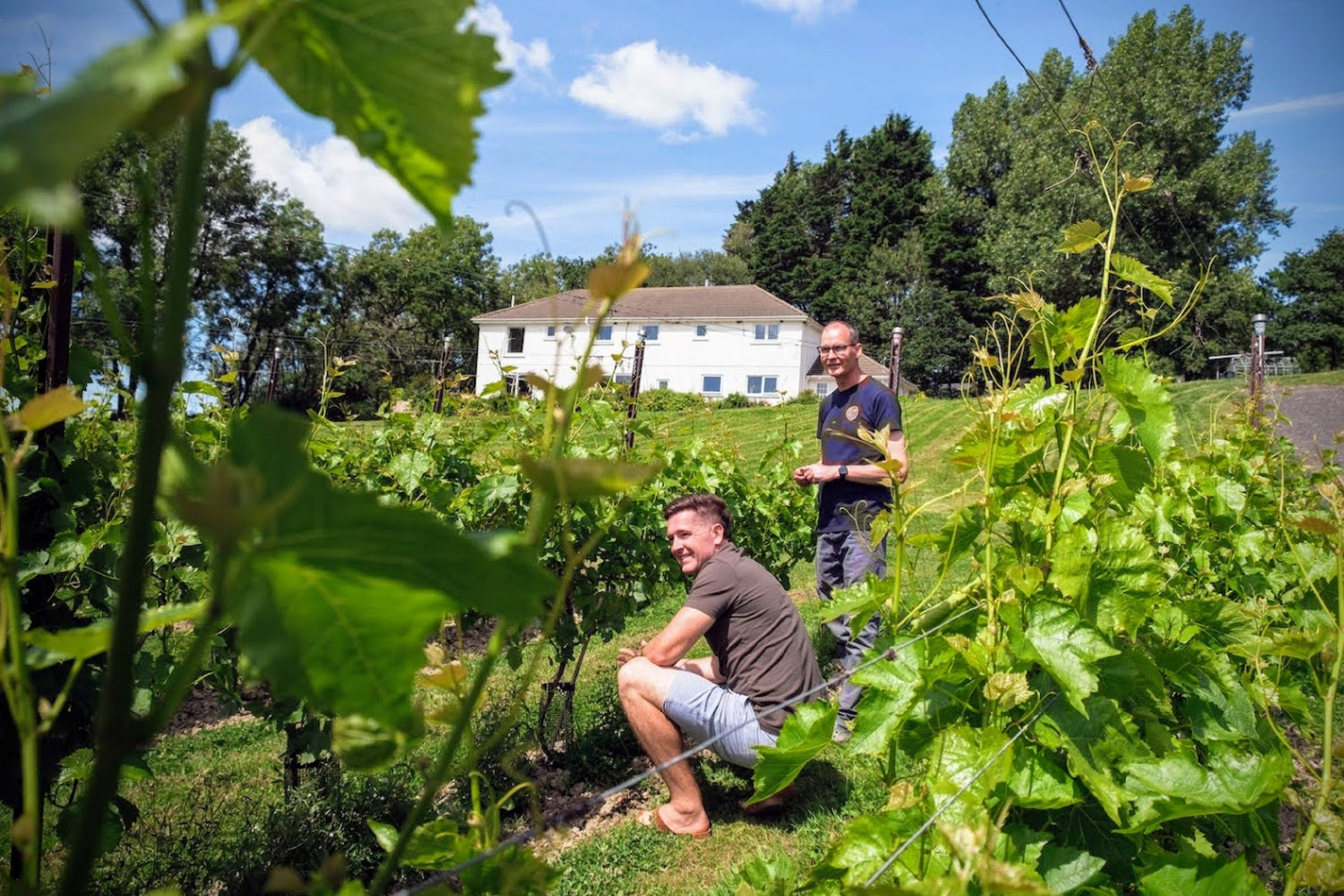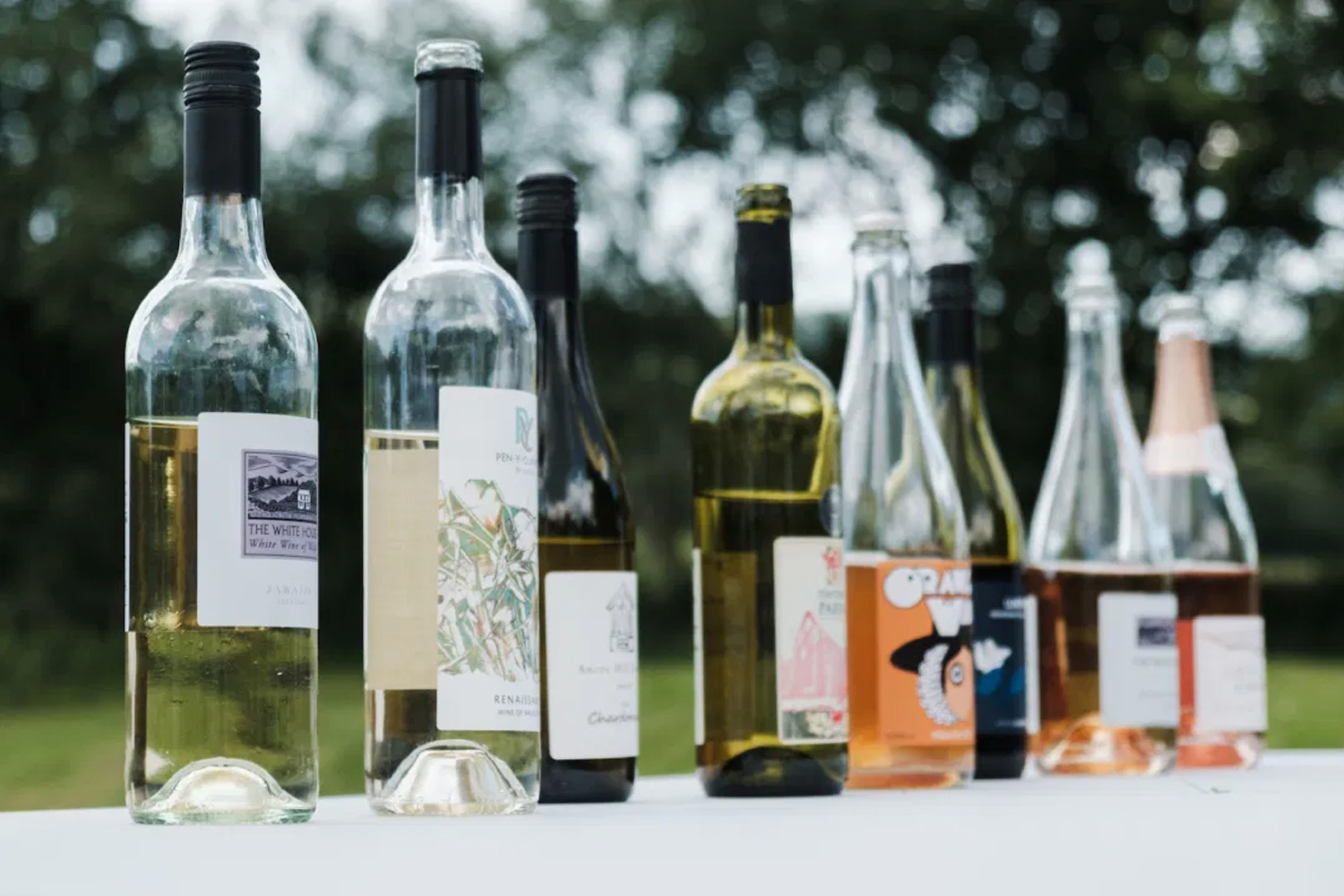You will struggle to find a single Welsh person who hasn’t spent time on a Pembrokeshire or Carmarthenshire beach. And travellers from all over the UK (and further afield) flock year-round to seaside towns such as Saundersfoot, Solva, Tenby, St Davids, Pembroke and Fishguard. The West Wales coastline is beauty personified. However, only a miniscule fraction of visitors ever set foot in one of West Wales’s vineyards.
I was invited to attend a Vineyards of Wales tasting at Velfrey Vineyard, to be recorded and premiered during the action-packed #WelshWineWeek. Not only was it a welcome opportunity to taste and discuss a diverse selection of Welsh wines (read on for tasting notes), it was also a valued chance to meet the Velfrey team and speak about their exciting projects.

The future of Velfrey Vineyard appears very safe in the hands of the passionate Mounsey family. Fiona, Andy and Ryan made the brave leap into vineyard ownership in 2017. After a site visit from Stephen Skelton, and numerous conversations with other Welsh producers, they decided on Seyval Blanc and Pinot Noir to support their sparkling speciality, and a select few Solaris rows for stills. There are 4k vines in total which will make them a medium-sized entrant in Welsh producer terms.
Their vineyard, visiting centre and beautiful family home are all situated on the same site less than 10 miles from the Pembrokeshire coastline. With a less than 30 minute’s drive from Tenby and Saundersfoot, they’re well-positioned for wine tourism.

Looking out of your bedroom window into your vineyard each morning is a sure motivation for obsessive pruning and vine management. And the Mounseys certainly seem meticulous to a tee. This makes their late spring frost damage that much more heartbreaking. In the early hours of the 12th of May, like many other vineyard owners, they lost a lot of fruit; many rows of Solaris and Pinot were damaged. Thankfully, the later ripening Seyval is going strong and looking great.
Awaiting their first harvest, next will come a further test of patience. The fruit will go to Halfpenny Green – the winery spearheading many of the recent Welsh success stories. With an eye on premium sparkling, I suspect we’re looking at 2022/23 disgorgement for the maiden Velfrey sparkler. I’ll be buying a bottle as soon as I can get my hands on one. With the local excitement surrounding Velfrey, I suspect many people won’t be far behind me.

Overlooking the vineyard, we enjoyed an enticing and varied eight bottle line-up. Some zesty, pure, floral-spiked whites, a Chardonnay of international quality, THE Orange Albariño, an off-dry red, and two charismatic sparkling rosés. And four of the bottlings were maiden vintages, which speaks of how fast the Welsh wine scene is moving.
I was joined at the tasting by Moses Medizza, Head Sommelier at Coast Restaurant, and Ben Holbrook, travel journalist. A video is available below, including brief discussion about each wine.
Read on for the tasting notes. Six of these wines have been made available in the form of a ‘Deliciously Diverse’ mixed case on the vineyard.wales website.
Jabajak White House 2014
Grapes: Phoenix & Seyval Blanc
Region: Carmarthenshire
This Phoenix and Seyval Blanc blend is the maiden vintage in The White House range from Jabajak in Carmarthenshire.
It’s a strong example of a bone dry, pure aromatic style. There’s a lot of green fruit flavour, under-ripe pear and lemon zest in the attack. There’s also medium intensity with a pleasant floral lift in the finish.
I was surprised to see this was from the 2014 vintage – this has aged in brave fashion and is not showing any real signs of maturity.
Pen-y-Clawdd Renaissance 2018
Grapes: Reichensteiner, Phoenix & Schönburger
Region: Monmouthshire
This is a maiden vintage from Pen-y-Clawdd in Monmouthshire. It’s a field blend of Reichensteiner, Phoenix and Schönburger. The Renaissance name is fitting for the significant turnaround Frenchman, Gilbert Viader, oversaw after buying the unkempt, inactive vineyard.
There’s a strong grapefruit and kiwi backbone with a combination of herbal and floral complexity, herbal (fennel and thistle) showing more on the nose, and floral (grass, white blossom) more on the palate. It’s fresh and pure with impressive length.
Tasted twice during #WelshWineWeek, this shines bright alongside other Welsh whites, and should not be overlooked.
Ancre Hill Chardonnay 2018
Grapes: Chardonnay
Region: Monmouthshire
This is the first of two wines from perhaps Wales’s most acclaimed producer, biodynamic and organic Ancre Hill, in Monmouthshire. They make wines in a classic and experimental style with an undeniable sense of authenticity.
This is a vigorous green, chiselled, acidity-driven style of Chardonnay for which the UK is becoming popular. It has under-ripe melon, greengage and sherbet with a lovely leesy complexity. The profile is lean, tight and the finish is very long.
I have to marvel at all this intensity from a non-chaptalized 10.5% Welsh Chardonnay.
Tintern Parva Bacchus 2017
Grapes: Bacchus
Region: Monmouthshire
Staying in Monmouthshire, Tintern Parva comes from Parva Farm Vineyard. It’s perhaps the most historically significant and picturesque of all Welsh vineyards; the vines can be seen from nearby Tintern Abbey, overlooking the River Wye. Judith Dudley, co-owner, has been a guiding force in the Welsh scene.
There’s a prominent citrus backbone which is a hallmark of Bacchus, but this is a more perfumed expression than I’m accustomed to. There’s a violet note and soapy character not typical of Bacchus.
A delicate and pretty wine, defined by that dried floral note.
Ancre Hill Orange Albariño 2018
Grapes: Albariño
Region: Monmouthshire
This wine is a talking point from the moment it arrives on any tasting table. Ancre Hill join Chapel Down (Kent) as the only vineyards planting Albariño in the UK. And Richard Morris chose the variety for this striking orange wine, using carbonic maceration, natural malolactic fermentation in oak, spending 10 months on lees and with 50 days skin contact. The unfiltered bottle is under crown cap.
There’s a tangerine orange hue with cloudy sediment and minimum sparkle on appearance and palate. The nose has cinnamon spiced apples beneath a layer of wet hay that’s pressing down on the fruity scents. The palate is considerably more refreshing than I was expecting. There’s a genuine sense of refreshment coming through the powerful flavours and tannins. I got notes of dried fruits, baked apple, cooking spices, and apricot fromage frais.
Not everyone will enjoy this, but I think the team at Ancre Hill will be rightly pleased with how it’s turned out.
Llaethliw Still Red 2018
Grapes: Rondo
Region: Ceredigion
Llaethliw are new and exciting entrants to Welsh wine. There’s confidence coming from the Ceredigion producer after planting 5k vines in 2009, 1.5k vines in 2010, 8k vines in 2016 and a further 4.5k vines in 2020. Their whites, red and sparklers are all very strong. Their future looks as bright as their wines.
This Rondo has a dark garnet appearance, with an intense nose of glazed cherry and rhubarb. I was caught off-guard by the sweetness in the attack; there’s a fair amount of residual sugar. This off-dry style takes the palate towards a confected red licorice and raspberry ice cream syrup. It’s not cloying, but quite crunchy, ripe and playful with plump tannins.
This is a totally unique wine that will provide a lot of enjoyment. But be careful with food pairings and don’t expect a classic style.
Jabajak The White House Sparkling Blush 2014
Grapes: Seyval Blanc & Regent
Region: Carmarthenshire
They’ve done a terrific job on the branding for this Seyval & Regent sparkler, and I love the history and heritage behind the White House origin story.
There’s distinct juicy strawberry on the nose. The palate balances the red fruit flavour with plenty of pithy citrus that Seyval brings. The acidity is great and the dosage feels well judged.
More lees ageing could have brought depth, but this works very well as a clean, refreshing, long rosé.
Gwinllan Conwy Rhosliw Pefriog Sparkling 2018
Grapes: Regent
Region: Snowdonia
Gwinllan Conwy have 3000 vines planted in Snowdonia, which is somewhat more northerly than the Derbyshire and Yorkshire vineyards which are considered amongst the most northerly over the border.
I believe this is the first traditional method Regent sparkler I’ve tasted. I got an initially tart, floral attack, which quickly gave way to strawberry coulis, rose water and light honey. The residual sugar makes for a very pretty style of rosé that’s carrying weight on the palate.
This is perfect for a drinker who doesn’t enjoy the fierce nature of some dry sparkling wine.


